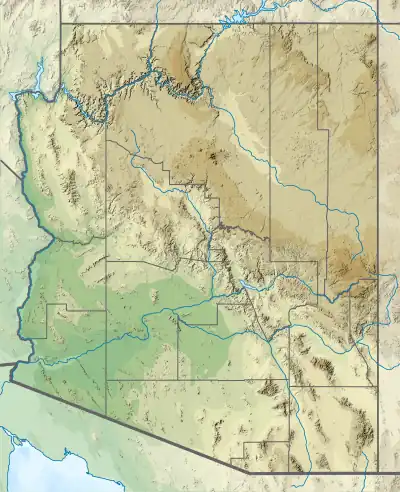| Brahma Temple | |
|---|---|
 North aspect at sunset | |
| Highest point | |
| Elevation | 7,551 ft (2,302 m)[1] |
| Prominence | 1,468 ft (447 m)[1] |
| Parent peak | Oza Butte (8,068 ft)[2] |
| Isolation | 3.97 mi (6.39 km)[2] |
| Coordinates | 36°07′50″N 112°02′19″W / 36.1304634°N 112.0387030°W[3] |
| Geography | |
 Brahma Temple  Brahma Temple | |
| Location | Grand Canyon Coconino County, Arizona, US |
| Parent range | Kaibab Plateau[1] Colorado Plateau |
| Topo map | USGS Phantom Ranch |
| Geology | |
| Type of rock | Coconino Sandstone |
| Climbing | |
| First ascent | May 15, 1968 |
| Easiest route | class 4 climbing[2] |
Brahma Temple is a 7,551-foot-elevation (2,302 meter) summit located in the Grand Canyon, in Coconino County of Arizona, US.[3] It is situated six miles (9.7 km) north-northeast of the Yavapai Point overlook on the canyon's South Rim, and 4.5 miles south of the North Rim's Bright Angel Point. It towers 5,000 feet (1,500 meters) above Phantom Ranch in Bright Angel Canyon. Its nearest higher neighbor is Oza Butte, four miles to the north-northwest.[1] Other neighbors include Zoroaster Temple one mile to the south, and Deva Temple, 1.5 miles to the north. Brahma Temple is named for Brahma, the Hindu creator of the universe. This name was applied by Clarence Dutton who began the tradition of naming geographical features in the Grand Canyon after mythological deities.[4] This geographical feature's name was officially adopted in 1906 by the U.S. Board on Geographic Names.[3]
The first ascent of the summit was made by Donald Davis and Clarence "Doc" Ellis on May 15, 1968.[5] The pair covered 12 miles and climbed 5,071 vertical feet from Phantom Ranch to reach the summit, and returned in 14 hours to complete the accomplishment.[6] According to the Köppen climate classification system, Brahma Temple is located in a Cold semi-arid climate zone.[7]
Geology
The summit of Brahma Temple is composed of cream-colored, cliff-forming, Permian Coconino Sandstone with a Kaibab Limestone caprock.[8] The sandstone, which is the third-youngest of the strata in the Grand Canyon, was deposited 265 million years ago as sand dunes. Below the Coconino Sandstone is slope-forming, Permian Hermit Formation, which in turn overlays the Pennsylvanian-Permian Supai Group, and further down the Mississippian Redwall Limestone layer.[9] Precipitation runoff from Brahma Temple drains south into the Colorado River via Bright Angel Creek on its west side, and Clear Creek on the east side.
Gallery
See also
References
- 1 2 3 4 "Brahma Temple, Arizona". Peakbagger.com. Retrieved 2020-12-18.
- 1 2 3 "Brahma Temple – 7,551' AZ". Lists of John. Retrieved December 18, 2020.
- 1 2 3 "Brahma Temple". Geographic Names Information System. United States Geological Survey, United States Department of the Interior. Retrieved 2020-12-18.
- ↑ Randy Moore and Kara Felicia Witt, The Grand Canyon: An Encyclopedia of Geography, History, and Culture, 2018, ABC-CLIO Publisher, p. 150.
- ↑ Todd R. Berger, Reflections of Grand Canyon Historians: Ideas, Arguments and First-Person Accounts, 2nd edition, 2008, Grand Canyon Association Publisher, ISBN 978-1934656006, p. 195.
- ↑ John Annerino, Hiking the Grand Canyon, 2017, Simon & Schuster, ISBN 9781510714984
- ↑ Peel, M. C.; Finlayson, B. L.; McMahon, T. A. (2007). "Updated world map of the Köppen−Geiger climate classification". Hydrol. Earth Syst. Sci. 11. ISSN 1027-5606.
- ↑ N.H. Darton, Story of the Grand Canyon of Arizona, 1917, p. 32.
- ↑ William Kenneth Hamblin, Anatomy of the Grand Canyon: Panoramas of the Canyon's Geology, 2008, Grand Canyon Association Publisher, ISBN 9781934656013.





